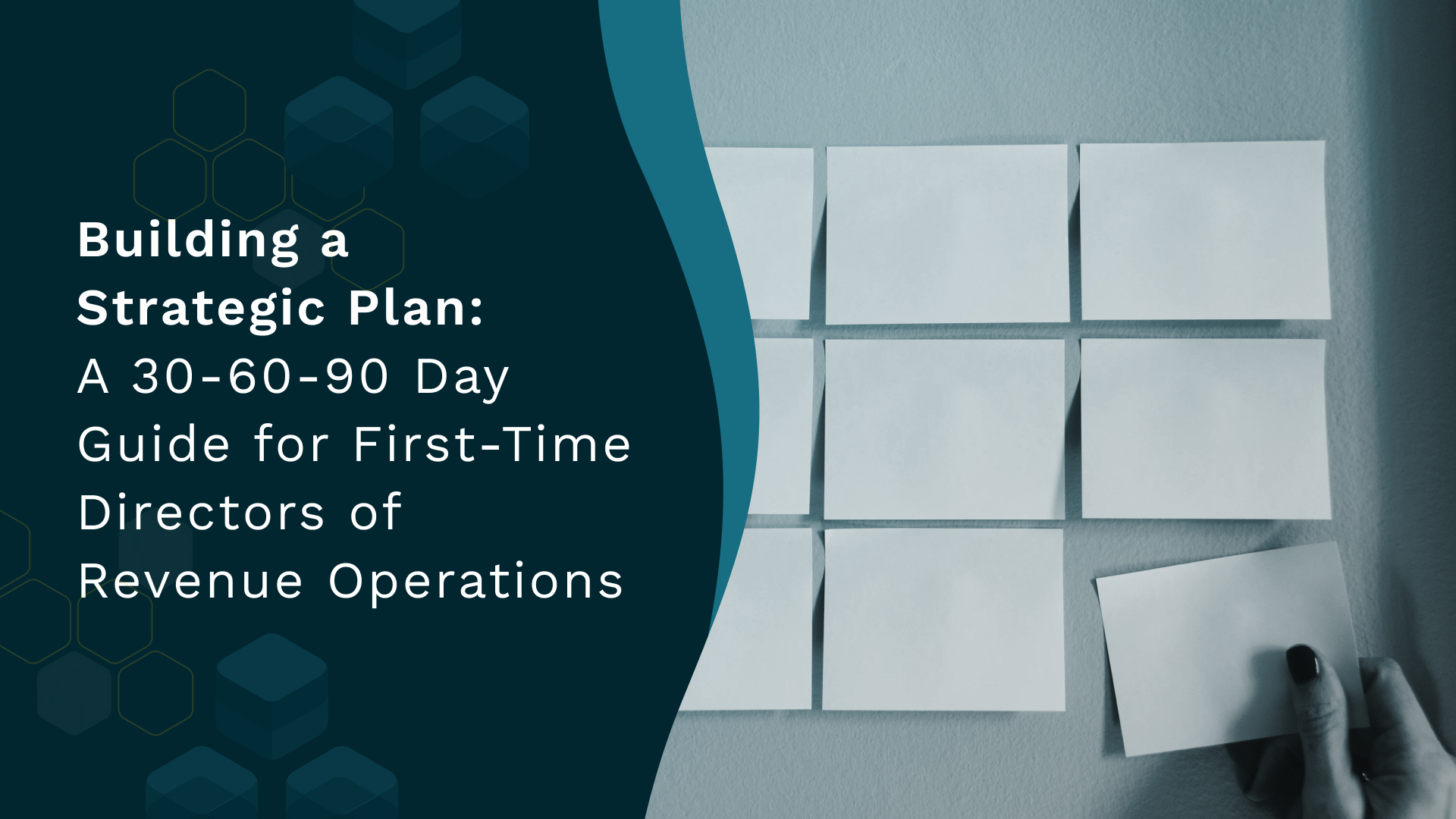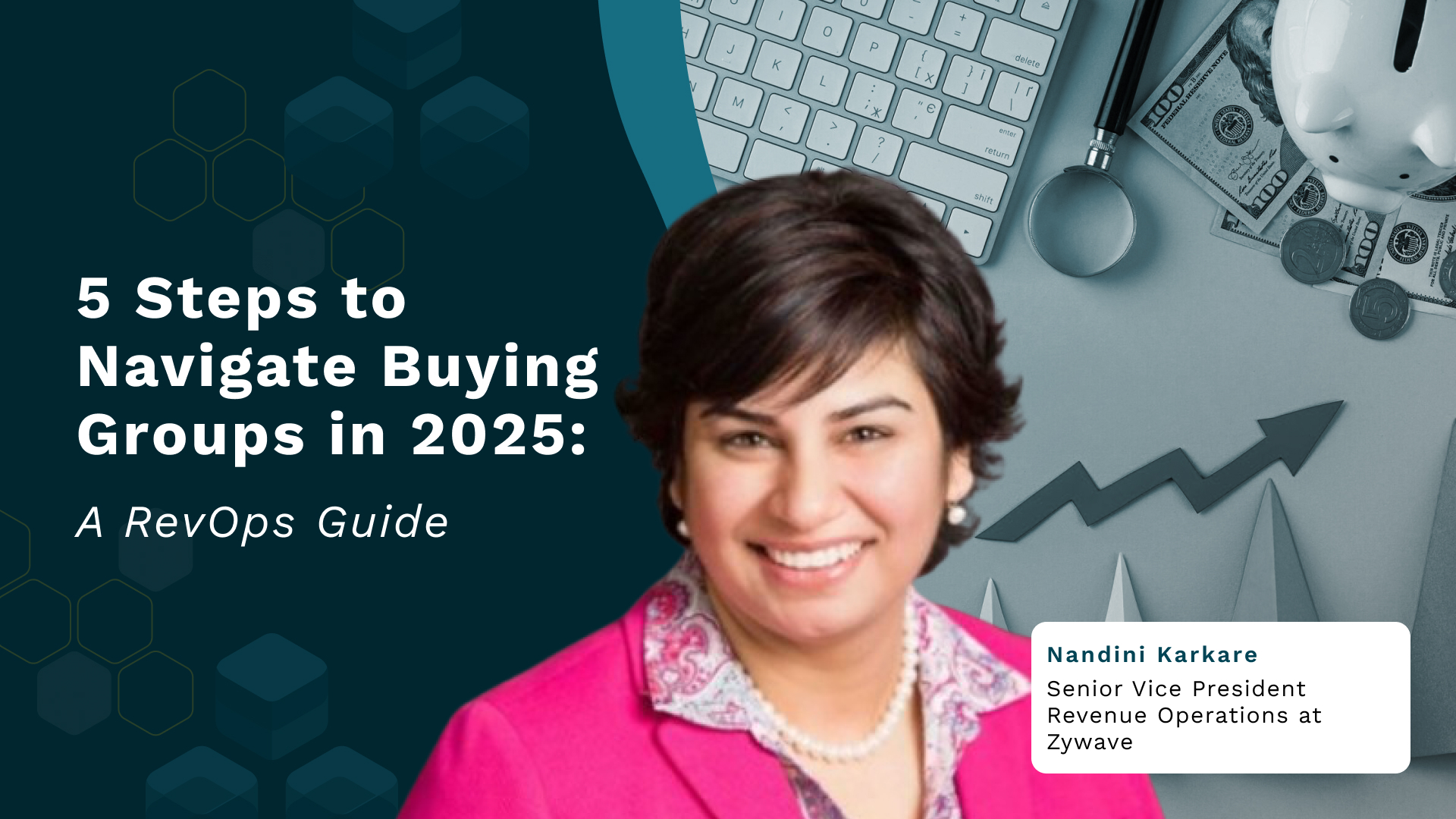A 30-60-90 Day Playbook for First-Time RevOps Leaders
A conversation with Hassan Irshad, Director of RevOps at FEVTutor.



Revenue Operations (RevOps) isn’t just a support function anymore. It’s the strategic engine that powers alignment, productivity, and visibility across the go-to-market (GTM) teams. And for first-time RevOps leaders stepping into the role, the first 90 days are absolutely critical. Your success depends on how well you can listen, diagnose, align, and act.
In this deep-dive, Hassan Irshad—former Director of RevOps at FEVTutor and a veteran in building RevOps functions from the ground up across multiple B2B SaaS organizations—shares a tactical, proven playbook for the first 90 days in the job. Structured into three phases, this playbook helps new leaders set up a high-impact, scalable RevOps engine.
Phase 1: The First 30 Days — Discovery and Trust-Building
Hassan calls this the “Discovery Phase,” and it’s arguably the most important segment of your 90-day plan. Here, the goal isn’t to solve every problem. It’s to understand the lay of the land, build stakeholder trust, and uncover real pain points.
“Think of yourself as a doctor. If you don’t listen well enough, you’ll misdiagnose the pain.”
Start by meeting with stakeholders across departments: Sales, Marketing, Customer Success, Finance, Product, and HR. Identify their KPIs, their blockers, and their goals. Create a document that captures all your findings—Hassan refers to this as the “Lay of the Land” doc.
At the same time, shadow end users. Sit with BDRs, AEs, and CSMs. Watch how they use tools. How do they enter data? Where do they get stuck? Walk through your CRM. Is reporting intuitive or a tangled mess?
Don’t stop there. Run a detailed tech stack audit. Map every tool in the ecosystem. What integrates with CRM? What’s shelfware? What’s overused or underused? Hassan emphasizes talking to users, not just system owners.
You should also:
Immerse yourself in the product: attend demos, listen to sales calls.
Map existing processes: selling, onboarding, renewals.
Identify low-hanging fruit for early wins: improve field logic, add help text, or train users on hidden CRM features.
Key Objectives:
Establish trust
Conduct a stakeholder audit
Perform a tech and process audit
Map current workflows
Identify quick wins
💡 Action Items:
| Task | Description |
|---|---|
| Stakeholder Interviews | Meet leaders from Sales, Marketing, CX, Finance, HR, and Product. Understand their KPIs, pain points, and top priorities. |
| Create a “Lay of the Land” Document | A central repository of org structure, current GTM processes, key workflows, and metrics. |
| Shadow GTM Teams | Sit with BDRs, AEs, and CSMs to understand how data is entered, how tools are used, and where bottlenecks occur. |
| Tech Stack Audit | List every tool in use, usage rates, integrations, costs, redundancies, and gaps. |
| Process Mapping | Map the end-to-end selling, marketing, and renewal processes. Identify handoffs, duplication, and inefficiencies. |
| Product Immersion | Attend a demo, listen to sales calls, and understand the sales pitch and product-market fit. |
✅ Quick Wins Template:
| Win Type | Example |
|---|---|
| Usability Fix | Clarify error messages in CRM workflows |
| Dashboard Build | Build a simple commissions dashboard for reps |
| Training | Conduct a quick session on a misunderstood feature |
Phase 2: Days 31-60 — Alignment and Control
This is the phase where you start “flexing your RevOps muscles,” as Hassan puts it. While discovery continues in some areas, you now begin putting controls and alignment mechanisms in place. Hassan calls this phase “Alignment and Control.”
“You need to be the catalyst for cross-functional collaboration. Nobody else is connecting the dots across sales, marketing, and CX.”
Start with KPI alignment. You’ll have already collected the individual KPIs in Phase 1. Now, assess whether those KPIs roll up into the broader company strategy. If they don’t, that’s a red flag—and your opportunity to bring the teams together.
Hold cross-functional syncs to align Sales, Marketing, and CS around shared quarterly goals. Create dashboards and reporting frameworks that reflect this shared accountability.
Also, start implementing operational controls:
Are close dates in CRM accurate?
Is forecasting behavior consistent?
Are stage definitions clear?
Don’t impose controls abruptly. Hassan suggests using logic and transparency. Example: If a rep uses spreadsheets to track deals, propose a CRM-based inline-editable report that feels like a spreadsheet but ensures visibility.
And begin vetting your tools:
Is a forecasting tool duplicating features available in Salesforce?
Are reps logging into a tool?
Can licenses be consolidated?
Key Objectives:
Improve GTM team collaboration
Put control mechanisms in place
Begin strategic alignment
Validate process improvements
💡 Action Items:
| Task | Description |
|---|---|
| Cross-Functional Alignment | Facilitate regular syncs between Sales, Marketing, and CX to align on quarterly goals. |
| KPI Rationalization | Align individual department KPIs with the company’s strategic objectives. Identify siloed or conflicting goals. |
| Governance Setup | Define request intake processes, project documentation standards, and response SLAs. |
| Control Implementation | Use logic and data to drive compliance (e.g., inline editable reports to update close dates instead of spreadsheets). |
| Change Management Prep | Identify stakeholders who will sponsor or resist change. Begin conversations to create buy-in. |
Phase 3: Days 61-90 — Vision and Execution
By now, you’ve earned trust, understood the landscape, and started building momentum. Phase three is about turning that momentum into long-term strategy and execution. Hassan calls this the “Vision and Execution” phase.
“You’re now setting the foundation for your long-term roadmap. Think beyond tickets—think strategy.”
At this point, you should be ready to publish a two-quarter RevOps roadmap. This roadmap includes:
Strategic initiatives tied to revenue goals
Operational improvements already underway
Planned enhancements to the tech stack
This is also the time to start tracking and showcasing impact. Go back to the baselines you gathered in Phase 1. Show how time-to-insight improved, or how a forecast accuracy initiative reduced missed commits. Make your work visible.
Remember, this is also where change management becomes critical. Stakeholders may resist new processes. Hassan advises using your discovery-phase insights to preempt resistance. Understand their motivations and frame changes as value drivers.
Key Objectives:
Publish a roadmap
Begin implementation
Showcase wins
Plan for continuous improvement
💡 Action Items:
| Task | Description |
|---|---|
| Publish a RevOps Roadmap | A two-quarter plan with milestones, tools, owners, and projected outcomes. |
| Implement High-Impact Projects | Focus on fixes that will yield meaningful business value—clean data, accurate forecasting, unified dashboards. |
| Vendor Management | Engage vendors for roadmap-aligned support, optimize licenses, or deprecate tools. |
| Executive Reporting | Build baseline-to-impact comparisons for metrics improved via RevOps. |
| Change Management Execution | Drive adoption by revisiting discovery insights, socializing impact, and enabling champions. |
📈 Roadmap Template:
| Quarter | Initiative | Owner | Impact Goal | Metrics |
|---|---|---|---|---|
| Q1 | Unified Commissions Dashboard | RevOps | Improve AE payout visibility | Rep NPS, Payout Accuracy |
| Q1 | Improve Forecasting Accuracy | RevOps + Sales Ops | Accurate pipeline projections | Forecast Accuracy YoY |
| Q2 | Renewal Process Automation | RevOps + CX | Reduce churn by 10% | Retention Rate, Renewal TAT |
After 90 Days: Iterate and Scale
The journey doesn’t end at Day 90. In fact, it just begins.
Version everything: Hassan’s advice is to treat every process like a product. Launch version 1.0, then iterate.
Prioritize ruthlessly: Not every idea makes the roadmap. Rank by impact, effort, and strategic alignment.
Celebrate your wins: Share improvements, metrics, and testimonials widely. This builds advocacy and credibility.
Final Thoughts
For first-time RevOps leaders, your first 90 days aren’t just about learning the ropes. They’re about defining your leadership style, establishing strategic value, and building a platform for scale.
Follow this 30-60-90 playbook, and you’ll go from being the new hire to the strategic architect of a high-performance revenue engine.
“If you can’t measure your impact, it didn’t happen. Treat your wins like closed deals—celebrate them.”
Want to hear more stories from revenue leaders? Subscribe to The Revenue Lounge podcast to never miss an episode!
More Resources

A 30-60-90 Day Guide for First-Time Directors of Revenue Operations
A 30-60-90 Day Guide for First-Time Directors of Revenue Operations RevOps 10 min Starting a new job as a Director of Revenue Operations is an exciting opportunity to make a significant impact on a company’s revenue growth. To ensure success in this role, it’s essential to have a strategic plan that guides your actions during the crucial first three months. Here’s a 30-60-90 day plan that will help you strategically manage revenue operations and drive sustainable growth. We recently spoke to Hassan Irshad, Director of RevOps at FEVTutor. He shared his approach to this powerful framework, demonstrating how each phase (30, 60, and 90 days) builds strategically upon the last to deliver alignment, trust, and sustained improvement. By breaking down complex goals into achievable milestones, the 30-60-90 day approach empowers RevOps leaders to initiate meaningful change without overwhelming teams. For all the RevOps leaders, it’s a way to approach change with purpose, driving measurable impact and laying the groundwork for long-term success. The 30-60–90 day framework must be an indispensable tool and here is how you can implement progressive, sustainable growth strategies from day one. First 30 days for a Director of Revenue Operations The purpose should be to gather insights and understand the organization, especially the needs and challenges of different teams. 1. Goals for first 30 days: i. Meet Key Stakeholders Meet with cross departmental teams like Finance, HR, and Sales to understand their goals, challenges, and priorities. ii. Document Everything Create a “lay of the land” document summarizing findings on different team goals, challenges, and processes. iii. Understand the Product Take product demos, listen to sales calls, and use tools that show how the product is sold. This helps in understanding the customer needs better. iv. Dive into Your CRM Understand your CRM (whether Salesforce or HubSpot) to assess how the data is organized. This is to check whether it’s easy to use, and identify immediate improvements. The CRM should be the central source of truth, with other tools supporting it. The data should be unified with easier adoption for the teams. v. Build Trust Internally Establish trust within your teams by listening carefully, asking questions about how RevOps can help, and addressing quick fixes to show you’re there to help. Having this trust shows them that you’re here to support their success. Quick wins, such as small fixes that make people’s jobs easier, helps in establishing credibility early. 2. Establish Clear KPIs i. Understanding Team KPIs It is important to ask you stakeholders about the KPIs that matter to understand their goals and what their expectations are. ii. Aligning KPIs Across Teams Different departments oftentimes work in silos. RevOps should strive to align these departments and check if these KPIs match the overall business objectives. Gaps must be closed if their KPIs don’t align. iii. Setting RevOps KPIs As you approach the end of the first 30 days, start establishing RevOps-specific KPIs that match company goals, which may involve metrics like revenue increase, conversion rates, or improvements in overall efficiency. 3. Tech Stack Audit Deep dive into the existing tools that your company is using. Identify all redundancies, and find opportunities to streamline the entire tech stack. i. Map Out Tools Compile a list of all tools used by teams, noting their purpose and how they work with the CRM. ii. Evaluate Use and Cost Determine if tools are actively used or if there are duplicates. Look for cost-saving opportunities by consolidating tools when possible. https://www.youtube.com/watch?v=sVDJ9KI1tGw&t=869s Next 30 days – Alignment and Control The next 30 days marks a shift from discovery to alignment. The goals should be to create cohesion between departments (e.g., Sales, Marketing) and laying down effective controls. The improvements need to be implemented without overwhelming the teams. This phase combines further exploration with actionable improvements with the primary task being bringing the teams into sync. 1. Ways to bring your teams together i. Encouraging cross-team collaboration by addressing silos and ensuring all teams work toward shared quarterly or company-wide goals. ii. By creating alignment, you help teams see RevOps as a support system rather than an enforcer. This keeps communication channels open and creates buy-in. iii. Based on your findings, introduce controls wherever needed to improve workflow. Example: If close dates aren’t being recorded properly, this could skew reports. Meet with sales, identify the root cause (e.g., manual data entry that is taking too much of a reps’ time), and provide solutions or tools to make their tasks easier. Ensure that controls are practical and developed with the trust built in the first 30 days. Foster internal consensus within teams so that these improvements are adopted seamlessly. 2. Navigate Organizational Politics (i) Barrier Removal Larger organizations may have internal politics or ingrained processes that resist change. Find an internal “sponsor” who trusts and supports RevOps initiatives and can authorize actions to navigate any resistance. (ii) Trust and Consistency As you implement changes, make sure your efforts consistently demonstrate how RevOps can make work easier and more efficient for everyone. 3. Evolving the Tech Stack (i) Assessing Tech Needs If tools aren’t fully integrated (e.g., a tool not writing data back to the CRM), identify their gaps and consider evolving the tech stack. (ii) Holistic View Use insights from the discovery and alignment phases to start envisioning necessary tech improvements that align with company goals. Beginning of the 90-Day Phase: Vision and Execution This phase, described as “Vision and Execution,” involves shaping and executing a strategy based on insights gathered from the discovery and alignment phases. a. Roadmap Creation Create a roadmap covering the next two quarters, focusing on long-term, high-impact changes that align with business goals. Use learnings based on stakeholder needs, organizational goals, and the findings from the first 60 days i. Set Priorities Collaborate with end users (Sales, Marketing, Customer Success) to understand their pressing needs and align the roadmap with these needs. ii. Strategic Execution Prioritize initiatives that will have immediate revenue impact or

Top 10 Relationship Intelligence Tools for 2025
Top 10 Relationship Intelligence Tools for 2025 RevOps 10 min When it comes to sales, building strong relationships is essential. But let’s face it, the process can be incredibly time-consuming and demands a significant amount of effort from the sales reps. But here’s the kicker: Today, 44% of millennial buyers prefer minimal contact with a sales rep during the buying process. That means your sales rep has ~5% of the prospect’s time to establish a connection. It’s tougher than ever to develop relationships from a seller’s point of view. Does this mean that your reps should stop building relationships? Should your reps just try and sell whatever they can to whoever you find? The answer to that is a resounding NO. In the digital era, data and insights are what drive sales . They have the potential to give out more information than you know about your prospects. CRMs capture all possible data, churning it and spurting out information that otherwise was not visible earlier. But wait. There’s more to sales success than your CRM. To truly understand your prospects, you need to dig deeper to uncover hidden insights to help close your deals faster. That means mining your CRM data for a wealth of valuable information that will give you a competitive edge. This is exactly what relationship intelligence does. What is a Relationship Intelligence Tool? Picture this: You have access to a wealth of data from your clients, colleagues, and partners, but it’s scattered across various touchpoints like emails, phone calls, messages, meetings, and more. How do you make sense of all that information? That’s where relationship intelligence comes in. By pooling in, processing, and analyzing all that data, relationship intelligence technology provides invaluable insights, builds stronger relationships, and helps you make smarter decisions. With relationship intelligence, you can discover a treasure of data-driven and actionable insights that support the organization’s understanding of the customer, identify the optimal solutions, and determine the best communication strategies. This results in a more tailored and informed approach to prospects to maximize the best chance of a positive outcome. Your prospects are more than just a phone number or an email. Relationship intelligence broadens your potential and plays a strong role in connecting the dots from other sources. It supplements your CRM, finding other & useful opportunities to close prospects, otherwise not visible to us. Why Does a Relationship Intelligence Tool Matter? Enterprise-based selling in B2B is no walk in the park. With a plethora of relationship intelligence tools out in the market, organizations are spoilt for choice. However, tools that leverage AI/ML, offering data-driven intelligence with invaluable and actionable insights, will be the ones that will dominate the market. On the flip side, the process of onboarding a tool no longer rests in the hands of a single decision-maker. Gartner states that the number of buyers involved in the last decade has increased from 5 to 20. A potential account will have multiple stakeholders who will be involved in the decision-making process. Hence, it becomes critical for sales reps to identify and engage with key stakeholders regularly. With the rise of digital selling, organizations can now track the process of selling in a more in-depth manner. All forms of digital outreaches and communication with prospects can now be tracked, analyzed, and acted upon with the help of relationship intelligence. Today, with markets being down and companies being extremely meticulous in their choice of tools to invest, having a relationship intelligence tech stack will be the game-changer. Here’s how 1. Showcasing a single view of all your relationships with your prospects Having relationship intelligence data will bring together all the stakeholders in one view, so sales reps have a clear idea of the sales cycle the account is currently in. 2. Identify every stakeholder involved With the buying process evolving constantly, the final decision often lies not with one but multiple owners. In other words, for a sales rep, multithreading is the best way forward. And in this process, it’s very easy to confuse the right person to engage with, especially if there is a handover involved. Sales reps often fail to map out the stakeholders involved. The dots are not connected and not visible, which can lead to confusion and no clarity to other higher authorities. Relationship intelligence tools fill these gaps. It will identify each & every stakeholder involved at every stage of the selling process, bring them together, and map out the relationship of each, and provide all the information about these stakeholders. Not only that, but the data also provide insights to those who are frequently engaging and also point out the next best champion to continue the sales process seamlessly if the key decision maker is unavailable at any stage of the sales process. 3. Give detailed insights about each prospect The thing about relationship intelligence tools is that not only do they provide details in one place, but they also show you the best possible way to contact and reach out to your prospects. It can be email, phone calls, or video calls; it will give you solutions that are sure to boost your process of converting. 4. Recover lost leads In the world of sales, not all leads or prospects will convert. If the target is to convert 2 leads in a month with a value of X, sales reps need to build a pipeline of at least 10 leads with a value of 10X. This results in 8 leads that will not convert or be disqualified or lost in the process. However, these 8 leads don’t have to be lost forever. With relationship intelligence, you can identify the most engaged buyers and reignite the relationship with them. And here’s the kicker: the relationship intelligence technology considers all the data even before onboarding the tool. This kind of intelligence will only unleash hidden superpowers for your sales reps. Who knows, your lost prospect’s business priorities might have changed over time, and getting back to them might just make all the difference. 4. Discover trends in

5 Steps to Navigate Buying Groups in 2025: A RevOps Guide
5 Steps to Navigate Buying Groups in 2025: A RevOps Guide RevOps 10 min In today’s business environment, B2B buying is never just one person. According to Forrester Research, more than half of global business buyers purchase in complex buying scenarios that include more people, more departments, and generally higher price points. And this buying group can be made up of 7 to 20 people! Unlocking the power of buying groups is a crucial aspect of the B2B landscape. This blog is a synopsis of our conversation with revenue operations leader, Nandini Karkare. She is currently the SVP of RevOps at Zywave. Nandini suggests strategic steps to navigate through the realms of Revenue Operations and helps uncover the strategies, insights, and best practices that constitute a comprehensive guide to mastering the dynamics of buying groups. Read on to get actionable tips on how you can navigate buying groups in 2025 (and beyond). And implement the learnings to create a winning GTM motion. Here are the 5 steps Nandini recommends: 1. Decode Your Buying Groups The buying groups typically consist of members from departments and they all contribute different aspects. It is critical to understand the scope of decision-making including the people who play the most significant roles in making the call. Gartner’s report on B2B Buying highlights that 77% of B2B purchases involve a buying group of four or more people. PS: The key stakeholder can turn out someone altogether different from who you had building a relationship with all along. a. Capturing Buying Group Members Effective buying group management means considering not just decision-makers but influential stakeholders across departments. Misidentifying key players or focusing solely on the main contact risks derailing the sale. (i) How can you map the entire buying group efficiently? Leverage internal and external data to identify the key players Segment the Group by Role and Influence (ii) Not everyone in the buying group holds equal power or influence. Segment them into categories: Decision-makers (who give the final heads-up) Influencers (who sway the decision) Users (who use the product and provide feedback) Budget owners b. The Role Transition Within a Buying Group Moving the focus from a buying group to a renewal or expansion committee includes knowing precisely who remains in the relationship, as well as who becomes more active as an account grows. (i) New roles may emerge in a Buying Group Technical or operational leaders may become more influential post sale, since they are now using the product. (ii) The focus shifts from buying to renewal The interaction should be more about the return on investment (ROI) of the product placed on the market, ongoing value delivery, and ongoing needs. (iii) Alignment between the buying groups and renewal committee Leveraging the same enthusiasm and relationships generated at the first-buying stage helps in anchoring the transitions and preventing any drop-offs in engagement. Related Resource: Navigate Enterprise Buying Committees: Strategies for Driving Alignment c. Understand the Personal and Collective Priorities of a Buying Group As per McKinsey & Company, B2B buying decisions increasingly require engagement across departments, with 60% of purchasing committees including members from outside traditional procurement, like IT and HR. (i)Alignment Between C-Suite and Technical Teams Decisions aren’t Made in a Vacuum Collaboration between C-suite and technical teams ensures a holistic approach to solving customer problems, creating stronger, more sustainable relationships Their cross departmental collaboration can help with: (ii) Alignment on Strategic Goals C suite executives need technical assistance to translate their strategic vision to reality that also aligns with company-wide objectives. (iii) Technical Validation These insights guide the C-suite in making informed decisions that fit technical infrastructure and future-proofing. (iv) Cross-functional Communication Bridging the gap between these two groups involves continuous, open communication, ensuring that technical evaluations don’t delay business goals but instead support them cohesively. iii. Understand the Product Take product demos, listen to sales calls, and use tools that show how the product is sold. This helps in understanding the customer needs better. iv. Dive into Your CRM Understand your CRM (whether Salesforce or HubSpot) to assess how the data is organized. This is to check whether it’s easy to use, and identify immediate improvements. The CRM should be the central source of truth, with other tools supporting it. The data should be unified with easier adoption for the teams. v. Build Trust Internally Establish trust within your teams by listening carefully, asking questions about how RevOps can help, and addressing quick fixes to show you’re there to help. Having this trust shows them that you’re here to support their success. Quick wins, such as small fixes that make people’s jobs easier, helps in establishing credibility early. 2. Establish Clear KPIs i. Understanding Team KPIs It is important to ask you stakeholders about the KPIs that matter to understand their goals and what their expectations are. ii. Aligning KPIs Across Teams Different departments oftentimes work in silos. RevOps should strive to align these departments and check if these KPIs match the overall business objectives. Gaps must be closed if their KPIs don’t align. iii. Setting RevOps KPIs As you approach the end of the first 30 days, start establishing RevOps-specific KPIs that match company goals, which may involve metrics like revenue increase, conversion rates, or improvements in overall efficiency. 3. Tech Stack Audit Deep dive into the existing tools that your company is using. Identify all redundancies, and find opportunities to streamline the entire tech stack. i. Map Out Tools Compile a list of all tools used by teams, noting their purpose and how they work with the CRM. ii. Evaluate Use and Cost Determine if tools are actively used or if there are duplicates. Look for cost-saving opportunities by consolidating tools when possible. https://www.youtube.com/watch?v=sVDJ9KI1tGw&t=869s Next 30 days – Alignment and Control The next 30 days marks a shift from discovery to alignment. The goals should be to create cohesion between departments (e.g., Sales, Marketing) and laying down effective controls. The improvements need to be implemented without overwhelming the teams. This phase combines